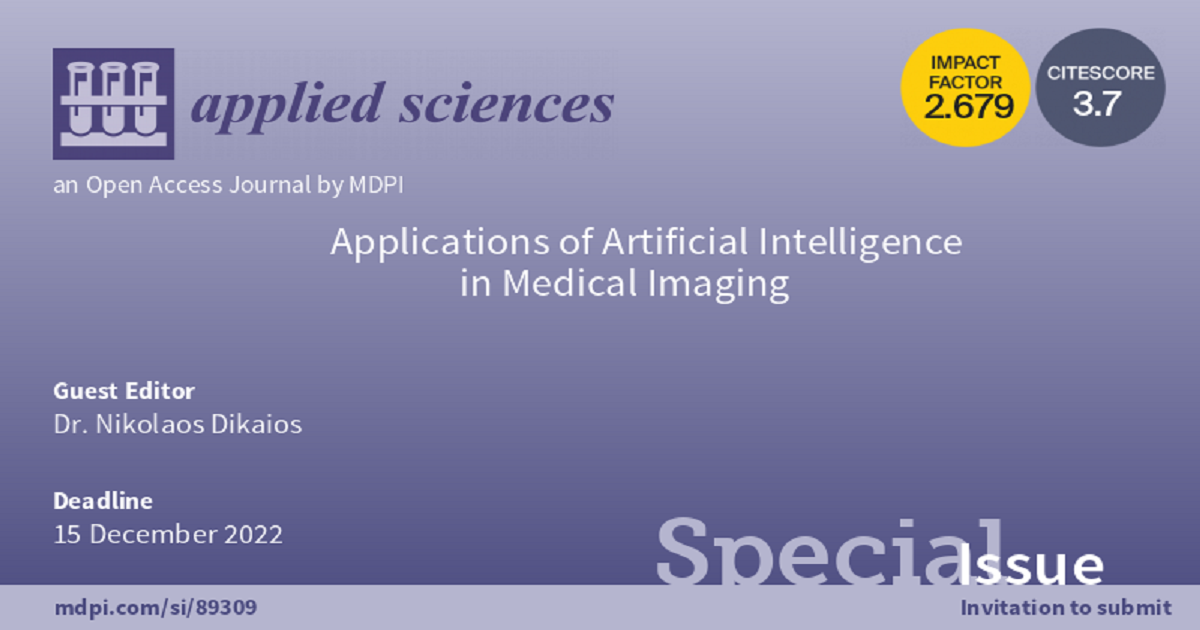Applications of Artificial Intelligence in Medical Imaging
A special issue of Applied Sciences (ISSN 2076-3417). This special issue belongs to the section "Computing and Artificial Intelligence".
Deadline for manuscript submissions: closed (15 December 2022) | Viewed by 32460

Special Issue Editor
Interests: tomography; inverse problems; mathematical optimisation; cancer informatics; physics
Special Issues, Collections and Topics in MDPI journals
Special Issue Information
Dear Colleagues,
Medical imaging aims to improve the diagnostic performance of various diseases and to help us to understand the underlying pathophysiology. Artificial intelligence (AI) is the new frontier in medical imaging offering innovative solutions in multiple tasks, such as reconstruction, segmentation, registration, and computer-aided diagnosis. The field of AI itself is rapidly evolving with new, exciting advancements, such as explainable AI and artificial general intelligence (AGI). The scope of this Special Issue is to translate recent advancements in the field of AI into medical imaging aiming to diagnose diseases earlier and more accurately, facilitate drug discovery, and enable personalized patient therapy.
Dr. Nikolaos Dikaios
Guest Editor
Manuscript Submission Information
Manuscripts should be submitted online at www.mdpi.com by registering and logging in to this website. Once you are registered, click here to go to the submission form. Manuscripts can be submitted until the deadline. All submissions that pass pre-check are peer-reviewed. Accepted papers will be published continuously in the journal (as soon as accepted) and will be listed together on the special issue website. Research articles, review articles as well as short communications are invited. For planned papers, a title and short abstract (about 100 words) can be sent to the Editorial Office for announcement on this website.
Submitted manuscripts should not have been published previously, nor be under consideration for publication elsewhere (except conference proceedings papers). All manuscripts are thoroughly refereed through a single-blind peer-review process. A guide for authors and other relevant information for submission of manuscripts is available on the Instructions for Authors page. Applied Sciences is an international peer-reviewed open access semimonthly journal published by MDPI.
Please visit the Instructions for Authors page before submitting a manuscript. The Article Processing Charge (APC) for publication in this open access journal is 2400 CHF (Swiss Francs). Submitted papers should be well formatted and use good English. Authors may use MDPI's English editing service prior to publication or during author revisions.
Keywords
- artificial intelligence
- medical imaging
- magnetic resonance imaging
- computed tomography
- positron emission tomography
- optical computed tomography
- ultrasound
- computer-aided diagnosis
- image reconstruction
- image registration
- image segmentation
Benefits of Publishing in a Special Issue
- Ease of navigation: Grouping papers by topic helps scholars navigate broad scope journals more efficiently.
- Greater discoverability: Special Issues support the reach and impact of scientific research. Articles in Special Issues are more discoverable and cited more frequently.
- Expansion of research network: Special Issues facilitate connections among authors, fostering scientific collaborations.
- External promotion: Articles in Special Issues are often promoted through the journal's social media, increasing their visibility.
- e-Book format: Special Issues with more than 10 articles can be published as dedicated e-books, ensuring wide and rapid dissemination.
Further information on MDPI's Special Issue polices can be found here.





